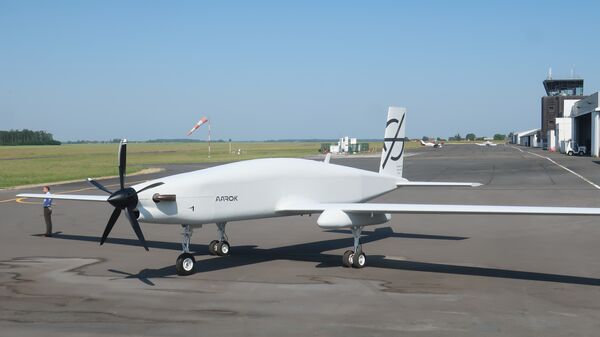- About
- Intara
- Capabilities
- Advisory
- Resources
- News
- Store
Ukraine conflict: Aarok UAV to be built in Ukraine
05 October 2023
by Gareth Jennings


The largest UAV to be built in France, the Aarok will now be built in Ukraine to help the country's war effort against Russia. (Turgis & Gaillard)
The Ukrainian government has agreed with the Turgis & Gaillard group to the in-country production of its Aarok unmanned aerial vehicle (UAV).
Signed as part of a wider raft of defence co-operation agreements between Ukraine and its allies, the Aarok production deal will see the French manufacturer and Antonov team on production of the medium-altitude long-endurance (MALE) UAV.
French newspaper La Tribune reported the development on 4 October, quoting Turgis & Gaillard founder Fanny Turgis.
First revealed at the Paris Air Show in June, the Aarok is the largest UAV designed in France. With a wingspan of 22 m and a maximum take-off weight of 5.5 tonne (of which 3 tonne is payload), the UAV is designed for intelligence, surveillance, and reconnaissance (ISR), communication relay, and strike.
Payloads include the Safran's Euroflir 610 electro-optical/infrared (EO/IR) sensor, as well as the Sagem SBU-54 Hammer AASM (Armement Air-Sol Modulaire) precision-guided bomb, and other air-to-surface munitions.
DARPA selects Aurora Flight Sciences for Phase 1B of SPRINT programme
21 May 2024
by Zach Rosenberg


Aurora Flight Sciences' proposal for DARPA's SPRINT contest. (Aurora Flight Sciences)
The US Defense Advanced Research Projects Agency (DARPA) has selected Aurora Flight Sciences to move into the next phase of the Speed and Runway Independent Technologies (SPRINT) programme, the company announced on 20 May, with a USD25 million contract modification.
The SPRINT programme is intended to result in an experimental vertical take-off and landing (VTOL) craft capable of reaching jet-like speeds.
SPRINT's Phase 1B is meant to advance designs from conceptual design review through preliminary design review, in which designers detail the component parts and specifications needed for the design.
DARPA selected four companies for Phase 1A of the programme in November 2023: Aurora Flight Sciences, Bell Helicopters, Northrop Grumman, and Piasecki Aircraft Corporation. The agency declined to specify whether additional competitors besides Aurora Flight Sciences were selected for Phase 1B.
SPRINT seeks designs capable of lifting off vertically from unprepared surfaces and cruising between 400 and 450 kt at up to 30,000 ft altitude with a 5,000 lb payload, according to the programme's initial solicitation. The programme was tendered in co-operation with US Special Operations Command (USSOCOM).
Singapore attributes F-16 crash to ‘rare' gyroscopic failure
20 May 2024
by Akhil Kadidal & Raghuraman C S


The crash of an RSAF F-16 on 8 May shortly after take-off has been attributed to an unusual gyroscopic malfunction. While the variant involved in the crash is not known, it is likely the single-seat ‘C' version (as depicted in this 2016 file photo) was involved. (Roslan Rahman/AFP via Getty Images)
A Republic of Singapore Air Force (RSAF) Lockheed Martin F-16, which crashed on 8 May, was found to have suffered simultaneous gyroscopic failure soon after take-off, according to the Singapore Ministry of Defence (MINDEF).
MINDEF said in a statement that the F-16 crashed on 8 May soon after it took off from Tengah Air Base. A joint RSAF-Lockheed Martin investigation has determined that the aircraft's pitch rate gyroscopes are to blame, MINDEF added on 18 May.
“The flight data recorder recovered from the crashed F-16 showed that its pitch rate gyroscopes gave erroneous inputs to the flight control computer (FLCC),” MINDEF said. “This led to the pilot being unable to control the plane at take-off.”
Poland completes receipt of Turkish UAVs
17 May 2024
by Gareth Jennings


Poland now has all 24 of the TB2 UAVs it ordered from Türkiye, operating them across four systems based at the 12th Unmanned Aerial Vehicle Base at Mirosławiec. (Polish MND)
Poland has received the last of 24 Baykar Bayraktar TB2 armed unmanned aerial vehicles (UAVs) from Türkiye.
The Polish Armaments Agency (AA) announced the milestone on 16 May, saying that the last four unmanned aircraft systems (UASs), each comprising six UAVs, had been received into the 12th Unmanned Aerial Vehicle Base at Mirosławiec on the same day.
“The Secretary of State in the Ministry of National Defense, Paweł Bejda, together with representatives of the Polish Armed Forces, took part in the ceremony of completing the delivery of the last, fourth set of the Bayraktar TB2 unmanned reconnaissance and strike system,” the AA said.
The Ukrainian government has agreed with the Turgis & Gaillard group to the in-country production of...
Latest Podcasts
The value of OSINT for intelligence sharing
In this episode Harry Kemsley and Sean Corbett are joined by Phil Ritcheson Ph.D. to discuss why intelligence sharing is now more important than ever. They discuss the growing need for allied and partnership and how by using open sources facilit...
Listen nowJanes Case Studies
Using Janes Intara to build a common intelligence picture: Russian build up on the Ukrainian border
View Case StudyNews Categories
 Air Details
Air Details